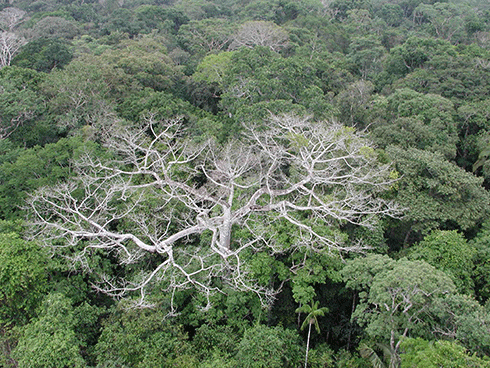
|
Published: 23 September 2013
Rainforest canopies may lose life under warming
A new study just published in Proceedings of the Royal Society B suggests that climate change may ‘flatten’ the Earth’s rainforests by pushing biodiversity groundward.

|
|
A towering canopy tree that died during a ‘megadrought’ in the Amazon rainforest during the summer of 2005, Western Amazonia, Brazil. Credit:
NASA/JPL-Caltech
|
Lead researcher Brett Scheffers of the Centre for Climate Change and Tropical Biology at James Cook University (JCU) in Townsville says ‘our findings suggest that the biodiversity that lives in the tree tops of rainforests may be pushed toward the cooler and wetter ground as the climate warms’.
This ‘flattening’, he said, could seriously alter the way tropical rainforests function.
Almost half of all known species in the tropics live in rainforest canopies but according to the researchers climate change may create an extinction zone that starts in the canopy and moves down towards the ground.
Mr Scheffers said that species were already moving uphill or towards the poles in search of cooler and wetter climates as the Earth warms and dries from climate change.
But he and his colleagues are the first to suggest that before this happens, species will first move out of the trees and towards the ground.
To collect data, Mr Scheffers and a large group of field researchers traversed a mountain in the tropical rainforests of the Philippines in search of frogs and other animals that live in the tree-tops.
‘A major reason why our study is unique is that rainforests consist of towering trees that are incredibly difficult to access with some over 50 metres in height,’ he said.
‘This discourages many researchers from conducting canopy research. Over the course of several months, we had to climb hundreds of trees to get our data.’
The researchers’ ‘flattening’ forest hypothesis is based on a century-old debate over what causes patterns of biodiversity.
‘We show that trees are as tall as mountains and as long as latitude in shaping biological patterns,’ he said.
The report says rainforest vegetation creates a climate gradient over a distance of just 20-30 metres that is far steeper than the changes in climate that may occur over hundreds of metres of elevation or kilometres of latitude.
The organisation of species from ground to canopy changes with altitude as species tend to move upwards in the rainforest strata as elevation increases.
‘We discovered a whole new dimension to biodiversity on Earth but in doing so we uncovered new consequences of climate change. We should carefully monitor for downward movements of rainforest species as this could be an early warning that rainforests are under stress,’ he said.
‘The Earth’s rainforests are certainly not flat but if citizens and governments do not take the necessary actions to prevent strong changes in climate, they could be.’
Source: JCU



